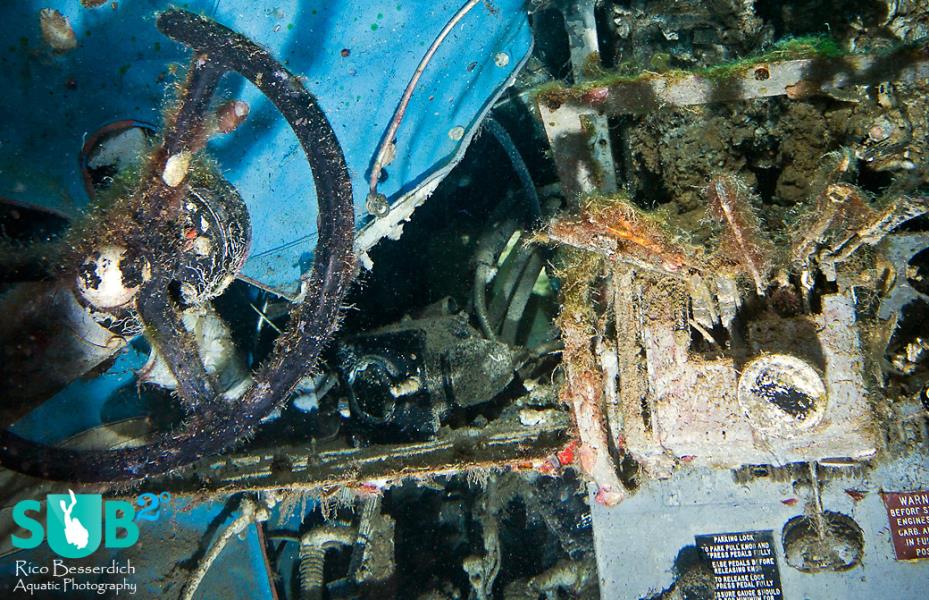-

Diving the skytrain
Diving the C47 "Skytrain" airplane in southern Turkey. -

A legendary aircraft underwater
One of the engines ( Pratt & Whittney 14-Cylinder ). -

Pilot's workplace
Lots of interesting small details in the cockpit of the Dakota. -

Roundtrip
A very different style of exploring an airplane - exclusive for divers only! -

Diving the skytrain
Diving the C47 "Skytrain" airplane in southern Turkey. -

Dive the Skytrain
Exploring the DC3 "Skytrain" aircraft. Lots of potential for uw photography!
Now that's a huge aircraft! Diving the Dakota DC3 in southern Turkey
Not as famous as the “Andrea Doria” and surely not as frequently penetrated by divers as the “Thistlegorm” but definitely worth a dive, is the “Dakota”, an airplane wreck located near a place called Kas, Mediterranean Sea, on the south coast of Turkey.
The correct name of this aircraft is DOUGLAS C47/DC III “Skytrain”. In civil aviation, it is known as “DC3”; in military usage, it was named “C47”. Originally this plane was designed as a “DOUGLAS Sleeper Transport”, providing flight passengers the possibility of a proper nap during travel. This concept was cancelled later on and the beds were replaced with seats.
There is no dramatic background story of our airplane wreck in Turkey. It served as a transporter for parachutists in the Turkish air force, and was donated to local dive centers after retirement to act as new artificial reef, and as a new dive attraction, of course. The sinking of the airplane at its final resting place happened on July 1st 2009 and was performed so smoothly that the DC3 lays now fully intact on the sandy seabed. It appears like it is just getting ready for its next take off ;-)
There is not much around the wreck, only sand and a little sea grass. This “isolation”, however, boots the visual effect when approaching: when swimming to it, you first see only a dark shadow; the closer you get, it turns more and more into a huge plane.
The engines, wings, cockpit, rudder and landing gear are all intact. A big door at the main hull, where the parachuters used to jump off the plane, provides access to the inside of the “Dakota”. The main cabin is quite empty but if you swim to the direction of the cockpit you can explore the working place of the navigation officer and the cockpit itself.
- You'll need a wide-lens or fisheye (10mm works well here).
- Plan to concentrate on single parts such as the engine or cockpit; 1 or 2 strobes come in handy. But for really wide-angle shots, it is a better idea to work with the ambient light only. Special filters such as the “Magic Filters” can help you restore colors here. If doing so, you better use a higher ISO level, such as ISO 400-800.
- The underwater visibility in the morning is way better than in the afternoon.
- If you dive there “by accident” with a macro lens: look for those juvenile blue-colored Mediterranean damselfishes that hide in the engines...or give the shrimp gobies a try ;-)
Technical details:
- Type/Name: Douglas DC3 / C47 “Skytrain”
- Manufacturer: DOUGLAS Aircraft Company, USA
- Build: 1935 to 1945
- Length: 19,65 Meters
- Wingspan: 28,96 Meters
- Weight: 12,25 tons
- Engines: 2 x Pratt & Whittney 14-Cylinder, 882 kW each
- Maximum speed: 360 km/h
- Crew: 3 persons
- Seats: 28-35
- Usage: civil and military cargo and passenger transport
Dive sport details:
- Name: “Lighthouse/Dakota”
- Location: Kas/Antalya – Turkey
- GPS coordinates: 36°10'53.15"N, 29°38'34.51"E
- Depth: 17-26 meters
- Best time to dive: June to October
Further Reading
Featured Posts
-

The Unique Diving of Guam
Often overlooked, the island of Guam is surrounded by fantastic diving. White sand beaches and calm, clear waters invite divers to explore the ocean and see the healthy coral and plentiful fish populations below.
-

Papua New Guinea's Milne Bay
Papua New Guinea is one of the world's best dive destinations and Milne Bay offers fantastic reef diving and muck diving in the same location. Clear waters and phenomenal creatures make for an excellent dive trip that’s enti...
-

Sharks of the Bahamas
Shark feeding dives are no longer just for the avid diver or thrill seekers. Bahama's crystal clear waters are the best environment to come nose to nose with a frenzied school of sharks after they smelled the chum.







Load more comments
TED BOHNE 9/24/2016 12:34:32 AM @ikender
Donald Douglas and company designed and built this aircraft to replace the DC-1 and DC-2, the DC-3 is the "wide body" version. the "DC' is for "Douglas Commercial"
TED BOHNE 9/24/2016 12:39:58 AM irina milotvorskaya, Dakota is the name the british gave it. Americans called them " Douglas Racers, Diesel threes, and others"
irina milotvorskaya 9/24/2016 4:27:22 AM Thanks! =)